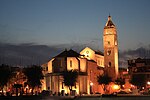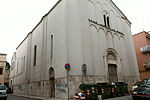Barletta railway station

Barletta railway station (Italian: Stazione di Barletta) is the main station serving the city and comune of Barletta, in the region of Apulia, southern Italy. Opened in 1864, it forms part of the Adriatic Railway (Ancona–Lecce), and is also a junction station for two other, regional, lines, the Barletta–Spinazzola railway, and the Bari–Barletta railway, operated by Ferrotramviaria. In the past, the station was also connected with the Port of Barletta, by a line ending at Barletta Marittima railway station, but that connection is now closed. The station is currently managed by Rete Ferroviaria Italiana (RFI). However, the commercial area of the passenger building is managed by Centostazioni. Train services on the Adriatic Railway and the Barletta–Spinazzola railway are operated by Trenitalia. Each of these companies is a subsidiary of Ferrovie dello Stato (FS), Italy's state-owned rail company. Services on the Ferrovie del Nord Barese are operated by Ferrotramviaria (FT).
Excerpt from the Wikipedia article Barletta railway station (License: CC BY-SA 3.0, Authors, Images).Barletta railway station
Sottopassaggio Stazione FS - Bari Nord, Barletta
Geographical coordinates (GPS) Address Nearby Places Show on map
Geographical coordinates (GPS)
| Latitude | Longitude |
|---|---|
| N 41.315277777778 ° | E 16.278611111111 ° |
Address
Barletta
Sottopassaggio Stazione FS - Bari Nord
76121 Barletta
Apulia, Italy
Open on Google Maps









